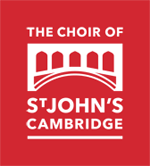Andrew Nethsingha on Tippett's 'St John's Service'
Posted on: 4 October 2019

Andrew Nethsingha discusses the significance of Tippett's 'St John's Service', a work which demonstrates a fresh, vivid and original take on the Evening Canticles. Read along whilst listening to Tippett's 'Magnificat' from the Choir's forthcoming album below.
It was a bold masterstroke on the part of choirmaster George Guest to commission Sir Michael Tippett (1905-1998) to compose a Magnificat & Nunc Dimittis to celebrate the 450th anniversary of St John’s College. The work was premiered in 1962, having been composed the previous year just after the completion of his second opera, King Priam. One hears Priam in the opening fanfare for the unique St John’s Trompeta Real organ stop. The opera had marked a major turning point in Tippett’s career – a shift to uncompromising clarity and concision after the radiant lyricism of earlier works. The great thing was that, unlike the other five composers on this album, Tippett had no life-long involvement in the Anglican choral tradition. He was not brought up singing Stanford, and indeed his Magnificat is the polar opposite of Mary sitting at her spinning wheel, a description often given to Stanford’s setting in G major. Tippett was able to bring an entirely fresh and vivid imagination to the texts.
Tippett’s two canticles could scarcely be more different from one another in character, yet at a deep level they form a single entity. The Nunc Dimittis is based on the same cluster of notes (C sharp, D, E) which permeated the Magnificat and indeed formed its very first chord. The opening four Trompeta notes are similarly procreant, for instance giving rise to the final chord of the Nunc Dimittis before the Gloria.

The Trompeta Royal on the Mander Organ of St John's College Chapel plays an important role in Tippet's St John's Service.
Over a Double Whisky Mac in the Baron of Beef, George Guest used to enjoy telling the story of the genesis of the new organ at St John’s in the 1950s. He told the College Council that every organ that was any good had an en chamade Trumpet stop (i.e. with pipes protruding horizontally.) The Council were interested and enquired where they could see and hear an example of the genre, expecting the answer to be nearby Ely Cathedral or perhaps Peterborough. ‘Madrid!’ was George’s reply. He got his way (as usual!) – and the Trompeta Real provided great inspiration for Tippett’s canticles, which are perhaps the finest setting of the past sixty years. The Trompeta is distinctly un-Anglican and this anti-establishment streak in Guest probably appealed to Tippett. The Magnificat is full of primeval, monolithic gestures. Tippett does not evoke a self-effacing innocence in the young Mary; instead we hear Mary’s awareness of the radicalism of the life that Jesus was going to lead. If parts of the Magnificat make people feel uneasy – well, that was the intention. The composer may even have had his own suffragette mother in mind whilst composing.
The choral textures are less complex than they sound – until the first Gloria none of the choral writing is in more than two parts, though the almost constant octave doubling imparts a distinctive elemental sonority. This was an ingenious solution to the question of how the choir could compete with the strident Trompeta Real stop, which is as loud as the whole of the rest of the organ put together. There’s a burst of energy at the word rejoiced, the choir’s one and only attempt to copy the organ semiquavers! The treble phrase for And his mercy is strikingly new and tender, perhaps suggesting God’s humanity. The tenors’ answering phrase throughout all generations seems to act as a bridge to the future. In the Lydian-mode opening to the first Gloria, Tippett enjoys prescribing wrong word stresses in the same headstrong way as Poulenc does in his Mass in G: Gloria in excelsis Deo. Tippett whips up an irrepressible energy, reminding us of the rhythmic vitality of late 1930s works such as Concerto for Double String Orchestra.
Concerning the Nunc Dimittis, George Guest wrote: ‘And what of the high treble soloist, who enunciates the words? Is it too fanciful to suggest that Simeon conceived them, was too weak to utter them, but that they were plucked out of his brain (by an angel?), and articulated?’ This outpouring of melody feels quite independent of the long low groans of the old man in the alto, tenor and bass parts. The organ part was described by Tippett as ‘the primitive onomatopoeias of the thunderings of God’. The canticle incorporates short passages of quasi-monastic chanting in the lower voices, for instance while the treble sings according to thy word. These, along with the pleading repetitions of the word Lord, add to a sense of prayers around the bedside of the dying man, perhaps in the manner of Elgar’s The Dream of Gerontius. The Nunc Dimittis Gloria is a quasi-Cubist construction, the phrases seeming to be cut out of paper, transposed to new keys, and then reassembled. Tippett’s visionary imagination is brought to bear on Simeon’s visionary words. The Magnificat had been intensely physical, but its thrust and rhythmic energy are now all gone. Time ceases to flow in an earthly way. The Nunc Dimittis is experienced in a dream, and it is a dream from which we don’t awake.
Andrew Nethsingha
Tippett's 'St John's Service' appears on Magnificat, which is released on Friday 25 October.
Pre-order, stream or download the album >
Organists’ Review


